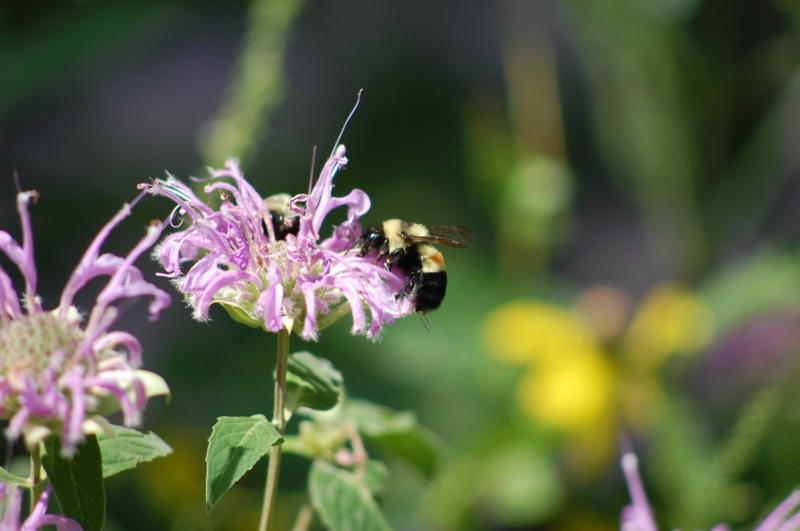Rusty-patched Bumble Bee

Species information
This chapter provides a review of progress towards the protection and recovery of Rusty-patched Bumble Bee in Ontario from 2007 to 2016.
Rusty-patched Bumble Bee (Bombus affinis) is medium to large in size; males and worker bees have a distinctive rusty-brown patch on the front half of the abdomen. The front and rear abdominal segments are yellow; all other segments are black. The species may be distinguished from other bumble bees by its entirely black head and face and the short space between the eye and the mandible (Colla and Taylor-Pindar 2011). Queens are larger and generally lack the rusty-coloured patch on the abdomen. The Rusty-patched Bumble Bee has a short tongue, but can access nectar from long-tubed flowers by piercing the petals, a behavioural adaptation known as “nectar-robbing.”
In the 1970s, Rusty-patched Bumble Bee was relatively common throughout its range in northeastern North America. The distribution map in Laverty and Harder (1988) indicates that the species was widespread in southern Ontario and southwestern Quebec. The map also shows a record from northeastern Lake Superior, which implies it may have been more widespread in northern Ontario at one time. Despite extensive targeted searches in Ontario from 2005 to 2009, only three specimens were observed. The last recorded sighting was in Pinery Provincial Park in Lambton County in 2009.
This bee species collects nectar and pollen from a wide variety of plants and has been found in a range of habitats including farmland, urban areas, grasslands, sand dunes, marshes and wooded areas. Old rodent burrows, hollow tree stumps and fallen dead wood provide nesting habitat. Over-wintering habitat has not been determined, but is likely similar to other Bombus species, consisting of underground burrows in loose soil or fallen dead wood (McFarlane 1974).
Rusty-patched Bumble Bee faces several threats to its survival and recovery including disease transmission from commercial, non-native bumble bee species, systemic pesticides, climate change and severe weather events as well as habitat loss from intensive land uses such as agriculture and urban development. In Ontario, because the species is at the northern limit of its range and occurs in areas with relatively specific climate conditions, it is vulnerable to changes in weather conditions that affect precipitation levels, soil humidity and forage availability.
The survival and recovery of Rusty-patched Bumble Bee are influenced by other factors as well. It is widely agreed that bee population declines are often driven by human-caused reductions in the abundance of food plants. However, some species may be more susceptible to these changes than others. It has been suggested that the drivers for decline differ among bumble bee species (Williams et al. 2009). For example, declines in B. affinis and B. terricola may be due to their susceptibility to pathogens (Thorp and Shepherd 2005; Winter et al. 2009).
Rusty-patched Bumble Bee is listed as endangered at both the provincial Species at Risk in Ontario and federal levels (Schedule 1 under the Species at Risk Act). Globally, it is considered to be critically imperiled (NatureServe).
Provincial status
The Committee on the Status of Species at Risk in Ontario (COSSARO) assessed Rusty-patched Bumble Bee as endangered. As a result, it was added to the Species at Risk in Ontario List under the Endangered Species Act, 2007 (“ESA” or “the Act”) in 2010. In future assessments, COSSARO may consider information gained through protection and recovery actions regarding the species’ threats and trends in population and distribution.
Species and habitat protection
Protecting Rusty-patched Bumble Bee and its habitat are key components in the implementation of the ESA, and continue to be government-led actions, as identified in the government response statement. As an endangered species, it has been protected from being killed, harmed, harassed, captured or taken under the ESA since it was listed in 2010. In addition, the species’ habitat has been protected from being damaged or destroyed since 2010. Habitat protection for the species was initially based on the general habitat definition in the ESA. The habitat of Rusty-patched Bumble Bee is now protected through a habitat regulation that came into force in 2014.
The government developed the habitat regulation (Ontario Regulation 242/08, Section 29.1.1) to provide clarity to the public and others on what areas are protected as Rusty-patched Bumble Bee habitat. The regulated habitat includes areas that are required by the species to carry out its life processes (e.g., nesting and hibernation) within its range in Ontario. The habitat regulation was developed based on information about the habitat needs of the species as well as social and economic factors, collected from a variety of sources including comments received through public consultation.
Any person who negatively impacts Rusty-patched Bumble Bee or its habitat without prior authorization may be prosecuted under the ESA.
Rusty-patched Bumble Bee has been protected from being killed, harmed, harassed, captured or taken since 2010.
In addition, the habitat of Rusty-patched Bumble Bee has been protected from being damaged or destroyed since 2010. Habitat protection was initially based on the general habitat definition in the ESA. The habitat of Rusty-patched Bumble Bee is now protected through a habitat regulation that came into force in 2014.
Recovery strategy
A recovery strategy for Rusty-patched Bumble Bee was published on December 7, 2011. Recovery strategies are advice to government and represent the best available scientific knowledge. The strategy identifies the habitat needs of Rusty-patched Bumble Bee and the threats that it faces, while recommending objectives and approaches for protecting and recovering the species. The recovery strategy also includes recommendations on the areas of habitat to be considered in the development of a habitat regulation.
Government response statement
The Ministry of Natural Resources and Forestry (“the Ministry”) published the government response statement (GRS) for Rusty-patched Bumble Bee on September 7, 2012, which was within the timeframe required by the ESA. The GRS is government policy that contains the Government of Ontario’s goal for the recovery of Rusty-patched Bumble Bee.
To help achieve this goal, the government leads and supports recovery actions identified in the GRS. Common actions for the government to lead as it works towards achieving a species’ recovery goal are provided in section 2.5 of the Species at Risk Program Status (2008-2015). A specific action in the GRS for the government to lead to help protect and recover Rusty-patched Bumble Bee is to:
Recovery Goal
The government’s goal for the recovery of Rusty-patched Bumble Bee is to maintain the current population level, and if possible, encourage the natural expansion of self-sustaining populations into suitable areas of its current and historic range in Ontario.
- Continue park restoration efforts, such as prescribed burning, in habitat where the Rusty-patched Bumble Bee has been found in Pinery Provincial Park.
The GRS for Rusty-patched Bumble Bee also lists six actions the Ministry supports others to undertake for the species. These government-supported actions fall under the objectives identified in the GRS, which are:
- Improve knowledge of the Rusty-patched Bumble Bee ecology and threats;
- Protect, maintain and improve habitat in Pinery Provincial Park; and
- Determine distribution and abundance of the Rusty-patched Bumble Bee.
Government-funded projects
An important government-led action in the GRS for Rusty-patched Bumble Bee is to support partners to undertake activities to protect and recover the species. Through the Species at Risk Stewardship Program the Ministry has supported a total of seven projects ($318,155) designed to contribute to the protection and recovery of Rusty-patched Bumble Bee. All of these projects targeted multiple species at risk, including Rusty-patched Bumble Bee, and partners reported that they were successful in securing additional funding ($727,355) from other sources. This amount includes additional funding and in-kind support in the form of time and expertise provided by volunteers.
Stewardship partners reported that provincial funding helped them to secure in-kind support by involving 401 individuals who volunteered 4,343 hours of their time toward protection and recovery activities for multiple species at risk, including Rusty-patched Bumble Bee, which has an estimated value of $88,995. The stewardship partners also reported that through their efforts and the efforts of their volunteers to implement actions contained in the GRS, they were successful in enhancing 4.4 hectares of habitat expected to benefit multiple species at risk, including Rusty-patched Bumble Bee. In addition, the partners reported providing outreach on multiple species at risk, including Rusty-patched Bumble Bee, to 37,692 individuals.
The Ministry also supports proponents in conducting research that addresses important knowledge gaps for species at risk. Through the Species at Risk Research Fund for Ontario, the Ministry provided funding to a partner to conduct research to learn more about the phenology, distribution, abundance and habitat needs of Rusty-patch Bumble Bee by studying a very similar and more numerous species, the Yellow-banded Bumble Bee (Bombus terricola). The project objectives included investigating how to increase the number of Yellow-banded Bumble Bee queens through a captive breeding program. The research results could then be applied to the conservation of Rusty-patched Bumble Bee and other bumble bee species.
The remainder of this section highlights a project supported through the Species at Risk Stewardship Program, as well as the corresponding government-supported recovery actions for the species.
Over the course of a three-year project, Wildlife Preservation Canada (WPC) undertook a number of activities to identify and protect Ontario’s at-risk pollinators and insect-pollinated plants. Key objectives specific to Rusty-patched Bumble Bee included expert surveys of the species’ historic locations, the launch of a citizen science survey program in Pinery Provincial Park, and providing guidance on priority areas and methods for habitat restoration projects within the Park. Annual surveys were conducted with no Rusty-patched Bumble Bees observed, but important information on the biodiversity of other at-risk pollinators was gathered. In 2015, in partnership with Ontario Parks, the first annual BumbleBeeWatch.org citizen science survey program was launched at Pinery Provincial Park. The program is intended to raise awareness of bee conservation and engage citizen scientists in surveys to gather data on populations of rare and declining bumble bee species, including the Rusty-patched Bumble Bee. Workshops were held that provided participants with hands-on training for collecting, photographing and identifying bumble bee species. In 2016, the program was expanded to include a Scout camp property adjacent to the Park, where remnant populations of the Rusty-patched Bumble Bee may exist. These project activities support the GRS actions to develop and implement a Rusty-patched Bumble Bee survey and monitoring program for Pinery Provincial Park and recent historical locations, and engage volunteers to undertake surveys using digital photographs to determine the presence or absence of the species. Over the three years of the project, WPC provided recommendations to Park staff in restoring extremely rare and sensitive ecosystems, such as the wet meadow areas between sand dunes known as pannes. The pannes have unusually high plant diversity and support a number of at-risk species including the Rusty-patched Bumble Bee.
Species at Risk Stewardship Fund
-
 $0
$0for Rusty-patched Bumble Bee exclusively
-
 $318,155
$318,155for multi-species projects that included Rusty-patched Bumble Bee
-
 $727,355
$727,355in additional funding and in-kind support
-
 7
7projects included the Rusty-patched Bumble Bee
-
 401
401volunteers
-
 4,343
4,343volunteer hours
-
 37,692
37,692people received outreach
-
 4
4hectares of habitat enhanced
Efforts to minimize adverse effects on Rusty-patched Bumble Bee
Supporting partners through permits and their associated conditions is an important government-led action.
Three permits have been issued for Rusty-patched Bumble Bee since the species has been protected under the ESA, all of which were ‘protection or recovery permits’ (i.e., 17(2)(b)). ‘Protection or recovery permits’ are issued if the purpose of the activity is to assist in the protection or recovery of a species at risk. Of the three permits, one was issued exclusively for Rusty-patched Bumble Bee and two were issued for multiple species, including Rusty-patched Bumble Bee.
One of the permits was issued to gather species at risk information to improve management and planning on federal lands in order to protect species at risk, including Rusty-patched Bumble Bee. Another was required to conduct surveys to determine presence or absence of species at risk, including Rusty-patched Bumble Bee, to inform future land use planning decisions. A third permit enabled surveys to be conducted at known historic sites for the species, including Pinery Provincial Park, to confirm presence or absence of the species, and search for additional populations.
In order to minimize adverse effects while surveying for Rusty-patched Bumble Bee, the permits included conditions such as: training in appropriate methods and techniques prior to carrying out the surveys; carrying out activities in accordance with an animal care protocol for the species; and releasing all captured individuals immediately upon identification, at the point of capture.
-
3protection or recovery permits
-
13registrations
Since 2013, 13 activities that may affect Rusty-patched Bumble Bee or its habitat have been registered for the purposes of Ontario Regulation 242/08 under the ESA. Five of the activities were registered under ‘Drainage works’ (section 23.9), and eight activities under ‘Species protection, recovery activities’ (section 23.17). The registrations enabled activities such as maintaining municipal drains and undertaking ecological conservation work to restore habitat for the species. These registrations require the registered individual to comply with all conditions of the regulation, such as:
- Implementing the steps in a mitigation plan developed by an expert on the species to help minimize or avoid any adverse effects on the species, and monitoring the effectiveness of the steps;
- Ensuring that any person carrying out any part of the activity receives training on how to identify the species and its habitat, potential threats to the species and its habitat by the activity, and the steps that must be taken to minimize any adverse effects;
- Updating mitigation plans every five years to include information obtained while monitoring the effects of the activity; and
- Reporting observations of the species to the Ministry using the Rare Species Reporting Form.
Occurrences of Rusty-patched Bumble Bee in Ontario
Natural Heritage Information Centre (NHIC)
Ninety-three populations
Since the species was listed as endangered in 2010, the Ministry’s central repository at the Natural Heritage Information Centre has received approximately 337 records. These records are based on observations between 1912 and 2009 and come from a variety of sources. Records submitted have helped to redefine where the species is known and has been known to occur and have provided additional information on the species’ habitat and threats. Based on available data, eight populations that were previously considered extant are now considered historical. A change from extant to historical reflects our knowledge of the population and may not be indicative of a change to the population itself. Historical populations may still exist, but updated information is not available.
All known historical sites in southern Ontario were surveyed by experts between 2005 and 2008, but no Rusty-Patched Bumble Bees were observed. In Pinery Provincial Park, in 2005, a single male was recorded. No individuals were found during park surveys conducted from 2006 to 2008, but in 2009, two individuals were observed there (COSEWIC, 2010).
It is possible that there are observations of Rusty-patched Bumble Bee that have not been submitted to the Ministry. Encouraging the submission of observations of Rusty-patched Bumble Bee to the Ministry is included in the GRS as a government-led action. Submission of species observations to the Ministry increases our knowledge of where they occur and can play an important role in assessing the viability of populations.
Everyone is encouraged, or may be required by an authorization or approval, to submit observations of the Rusty-patched Bumble Bee, and any other species at risk observed, to the Natural Heritage Information Centre for incorporation into the provincial record of observations.
337 observations of the species were submitted to the NHIC since 2010
Summary of progress towards meeting the recovery goal
Summary of progress
Progress has been made toward all of the government-led actions and the majority of government-supported actions outlined in the GRS for Rusty-patched Bumble Bee. The Government of Ontario has directly undertaken actions to:
- Continue park restoration efforts, such as prescribed burning, in habitat where the Rusty-patched Bumble Bee has been found in Pinery Provincial Park,
- Educate other agencies and planning authorities on the requirement to consider the protection of the species and its habitat;
- Encourage submission of Rusty-patched Bumble Bee data to the Natural Heritage Information Centre;
- Undertake communications and outreach to increase public awareness of species at risk in Ontario;
- Protect the species through the ESA and its habitat through a habitat regulation;
- Support partners to undertake activities to protect and recover the species; and
- Establish and communicate annual priority actions for support.
Leading the protection and recovery of Rusty-Patch Bumble Bee in Pinery Provincial Park
Ministry staff in Pinery Provincial Park are continuing to work with conservation partners to support citizen science survey and monitoring programs, such as Bumble Bee Watch. Through this collaborative effort to track and conserve bumble bees, park visitors can participate in bee survey activities that provide an engaging learning experience for the visitor and help to inform the Ministry of bee activity in the area.
Ministry staff have also undertaken substantial efforts (including prescribed burns and removal of anthropogenic features) to maintain or restore habitat types preferred by Rusty-patched Bumble Bee within the park. In particular, a deer management program conducted in partnership with local Indigenous communities has significantly reduced degradation of habitat and increased populations of nectar-producing plants. Among other benefits, the work has resulted in the enhancement of sensitive pannes habitat, which are the wet meadow communities found between sand dunes and provide habitat for the Rusty-patched Bumble Bee and other rare species. A continued effort to eradicate invasive plant species from the park also demonstrates the commitment by the Ministry to undertake prudent management of native pollinator habitat within Pinery Provincial Park.
Government-supported actions are organized under over-arching recovery objectives. Progress has been made toward all of the government-supported recovery objectives and the majority of the associated actions that are identified in the GRS for Rusty-patched Bumble Bee.
Under the objective to improve knowledge of the Rusty-patched Bumble Bee ecology and threats, initial progress has been made towards two of the actions.
- Undertake research on basic biology such as phenology, response to restoration practices, population dynamics, overwintering, and foraging and nesting requirements (Action No. 2); and
- Determine lethal and sub-lethal effects of pesticides, such as the neonicotinoids, on native bumble bee species. This research should be carried out only on species that are not currently declining (Action No. 3).
These actions have been implemented through projects supported by the Species at Risk Stewardship Program. Research on the effects of a neonicotinoid pesticide on reproductive success of the Yellow-banded Bumble Bee, a similar species, was conducted. Knowledge was gained about bumble bee population stability through a research project that examined phenology, abundance, diversity, and distribution of Yellow-Banded Bumble Bee queens.
Under the objective to protect, maintain and improve habitat in Pinery Provincial Park, initial progress has been made towards this action.
- Develop and promote best management practices for landowners and greenhouse managers surrounding Pinery Provincial Park to reduce potential threats, such as the spread of pathogens and the effects of harmful pesticides (Action 4; High Priority).
This action was implemented through several projects supported by the Species at Risk Stewardship Program in which partners developed and delivered education and outreach programs about the importance of pollinators such as the Rusty-patched Bumble Bees and other bumble species, why they are at risk and how we can help create and protect bee habitat.
Under the objective to determine distribution and abundance of the Rusty-patched Bumble Bee, progress has been made on these actions.
- Develop and implement a Rusty-patched Bumble Bee survey and monitoring program for Pinery Provincial Park and recent historical locations (past 15 years) (Action 5); and
- Engage volunteers (e.g., field naturalist groups) to undertake surveys, using digital photographs to determine the presence or absence of the species (Action 6).
These actions were implemented through several projects supported by the Species at Risk Stewardship Program. One partner developed a bee survey protocol and provided Rusty-Patched Bumble Bee identification and survey training to staff and citizen scientists at Pinery Provincial Park. Other partners participated in the creation and expansion of the Bumble Bee Watch program, an important public engagement and education initiative. As a result, surveys and monitoring for Rusty-patched Bumble Bee both within and beyond Pinery Provincial Park are ongoing.
The recovery goal for Rusty-Patched Bumble Bee is to maintain the current population level, and if possible, encourage the natural expansion of self-sustaining populations into suitable areas of its current and historic range. Public and landowner engagement is a key factor in the protection and recovery of the species. The efforts of stewardship partners have greatly expanded citizen science opportunities and bumble bee habitat stewardship. Development and use of survey protocols and production of best management practices for distribution to specific audiences, both funded through the Species at Risk Stewardship Program, have resulted in progress towards this goal. Efforts need to continue to determine the level of recovery of Rusty-patched Bumble Bee as a result of these efforts.
Recommendations
As stated in the GRS, the review of progress towards protecting and recovering Rusty-patched Bumble Bee can be used to help identify whether adjustments are needed to achieve the protection and recovery of the species. Based on progress to-date, the overall direction provided in the GRS for Rusty-patched Bumble Bee should continue to guide protection and recovery actions for the species, particularly for those actions identified as high priority in the GRS.
Relative to actions that have received a high level of support, the following action has received less support and may be considered in future decisions regarding the protection and recovery of Rusty-patched Bumble Bee.
- Determine the cause of the rapid and widespread decline of the Rusty-patched Bumble Bee (Action No. 1; High Priority).
The difficulty in conducting research on this extremely rare bumble bee species is a limiting factor on progress towards the GRS objective to improve knowledge of its ecology and threats. However, research on similar species that have not experienced the same level of decline could provide valuable knowledge towards the protection and recovery of the Rusty-patched Bumble Bee in Ontario. Actions that require more work include understanding the basic biology of this bumble bee species, and researching the lethal and sub-lethal effects of pesticides on native bumble bee species in general.
Moving forward, protecting and recovering Rusty-patched Bumble Bee will continue to be a shared responsibility that will require the involvement of many individuals, organizations and communities. Financial support for the implementation of actions may be available through the Species at Risk Stewardship Program. The Ministry can also advise if a proposed project may result in adverse impacts to the species or its habitat and, if impacts cannot be avoided whether an authorization may be required. By working together, progress can continue to be made towards protecting and recovering Rusty-patched Bumble Bee in Ontario.
Summary of progress toward the protection and recovery of Rusty-patched Bumble Bee (2007 to 2016)
Provincial status
Rusty-patched Bumble Bee is classified as endangered under the Endangered Species Act, 2007 (ESA). The species has been protected from being killed, harmed, harassed, captured or taken and its habitat has been protected from damage or destruction under the ESA since 2010. Habitat protection for the species is now based on a habitat regulation that came into force in 2014.
Species-specific documents and guidance published by the government
- Recovery strategy for Rusty-patched Bumble Bee (2011)
- Rusty-patched Bumble Bee: Ontario Government Response Statement (2012)
- Rusty-patched Bumble Bee Habitat Regulation (Ontario Regulation 242/08) (2014).
Government-supported stewardship projects
- Through the Species at Risk Stewardship Program, the Ministry of Natural Resources and Forestry (“the Ministry”) has enabled its stewardship partners to conduct a total of seven projects ($318,155) that have supported the protection and recovery of multiple species at risk, including Rusty-patched Bumble Bee.
- The Ministry’s support helped its stewardship partners to involve 401 individuals who volunteered 4,343 hours of their time toward protection and recovery activities for species at risk, including Rusty-patched Bumble Bee. The estimated value of these voluntary contributions, as well as additional funding and in-kind support, is $727,355.
- Stewardship partners reported that through their actions 4.4 hectares of habitat were enhanced for Rusty-patched Bumble Bee and other species at risk that inhabit the same ecosystem.
- Stewardship partners also reported providing outreach on multiple species at risk, including Rusty-patched Bumble Bee, to 37,692 individuals.
- Through the Species at Risk Research Fund for Ontario, the Ministry supported a research partner to learn more about the phenology, distribution, abundance and habitat needs of Rusty-patch Bumble Bee by studying a very similar and more numerous species, the Yellow-banded Bumble Bee. The research also included an investigation into captive breeding techniques.
Supporting human activities while ensuring appropriate support for species recovery
- The Ministry has issued three ‘protection or recovery permits’ under clause 17(2)(b) of the ESA.
- Thirteen activities have been registered for the species. The activities were registered under ‘Ecosystem protection’ (section 23.11) and ‘Drainage Works’ (section 23.9) under Ontario Regulation 242/08 of the ESA.
Occurrences and distribution
Ninety-three populations of Rusty-patched Bumble Bee have been documented in southern Ontario. Currently, seven of these populations are considered to be extant, whereas the remaining 86 are considered historical. Rusty-patched Bumble Bee was last observed in 2009 in Pinery Provincial Park.
Related information
- Categorizing and Protecting Habitat under the Endangered Species Act
- Habitat Regulation Summary for Rusty-patched Bumble Bee
- Natural Heritage Information Centre
- Ontario’s Endangered Species Act
- Ontario’s Endangered Species Act Regulation 242/08
- Ontario Recovery Strategy and Government Response Statement for Rusty-patched Bumble Bee
- Policy Guidance on Harm and Harass under the Endangered Species Act
- Species at Risk in Ontario List
- Species at Risk Stewardship Program
References
Colla, S.R. and A. Taylor-Pindar. 2011. Recovery Strategy for the Rusty-patched Bumble Bee (Bombus affinis) in Ontario. Ontario Recovery Strategy Series. Prepared for the Ontario Ministry of Natural Resources, Peterborough, Ontario. vi + 21 pp.
Laverty, T. and L.D. Harder. 1988. The Bumblebees of Eastern Canada. Canadian Entomologist. 120: 965-987.
MacFarlane, R. P. 1974. Ecology of Bombinae (Hymenoptera: Apidae) of Southern Ontario, with emphasis on their natural enemies and relationships with flowers. PhD. thesis, University of Guelph, Guelph, ON, Canada.
Thorp, R.W., and M.D. Shepherd. 2005. Profile: subgenus Bombus Latreille, 1802 (Apidae: Apinae: Bombini). Page 5 in M. D.Shepherd, D. M.Vaughan, and S. H.Black, editors. Red list of pollinator insects of North America. The Xerces Society for Invertebrate Conservation, Portland, Oregon.
Williams, P.H., S.R. Colla and Z. Xie. 2009. Bumble bee vulnerability: common correlates of winners and losers across three continents. Conservation Biology 23: 931-940.
Footnotes
- footnote[1] Back to paragraph A population is defined as an area of land and/or water on/in which an element (e.g., Rusty-patched Bumble Bee) is or was present. They are comprised of one or more observations and the area has a practical conservation value as it is important to the conservation of the species. An element occurrence is the technical term used to describe this.
- footnote[2] Back to paragraph A population is considered historical if it has not been recorded within the last 20 years. Historical populations may still exist, but updated information is not available.